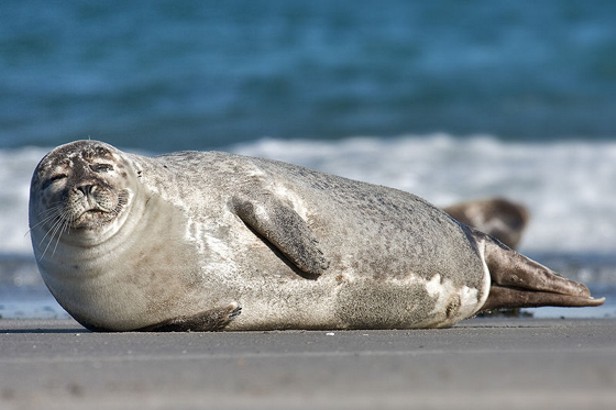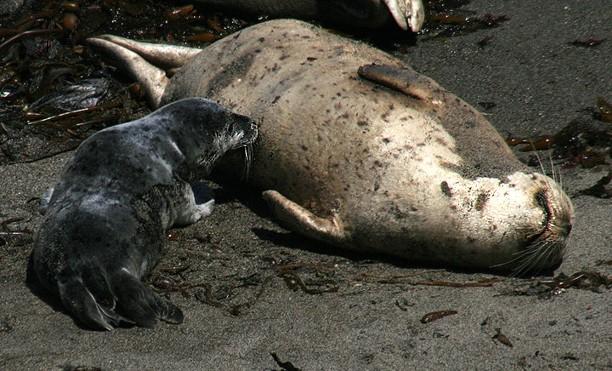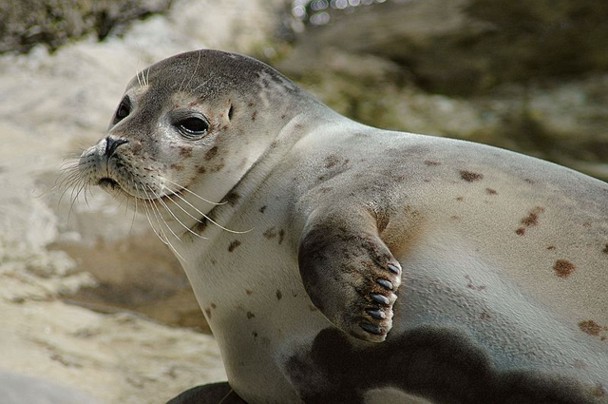Lessico
Foca comune
Phoca vitulina

La foca comune (Phoca vitulina) è un mammifero carnivoro appartenente alla famiglia dei Phocidae. Vive nelle acque costiere dell'Atlantico settentrionale dalla costa di Murmansk e dall'Islanda fino alla Francia e al Portogallo e dalla Groenlandia e dal Labrador fino al New Jersey; è presente anche nel Mare del Nord, nel Mar Baltico e nel Golfo del Messico; è diffusa nel Pacifico settentrionale dal Messico alla California meridionale fino al Mare di Bering e al mare di Okhotsk.
Lunga 160-200 cm, raggiunge il peso di 75 kg. Il mantello è formato da peli setolosi rigidi e lucenti, sotto i quali si stende una incerta lanugine, è di colore prevalentemente grigiogiallino con macchie marroncine o nerastre sul dorso. I piccoli appena nati sono coperti da una lanugine bianca, ma perdono questo loro pelo di gioventù già durante o poco dopo la nascita. Il corpo si assottiglia gradualmente dalle spalle alla coda, è tondo e affusolato. Anche la testa è decisamente tonda e ricorda più quella di un gatto che quella di un cane. Il muso è corto e dal labbro superiore si dipartono dei mustacchi di dure setole un po' ondulate. Gli occhi sono grandi, scuri e vivaci. Il canale uditivo, privo di padiglione, è rivelato da una piccola protuberanza triangolare nell'orbita.
La piccola foca poche ore dopo la nascita è in grado di nuotare e immergersi e, anche in caso di pericolo, di seguire il branco in fuga. Senza essere spinta o incitata dalla madre entra subito nell'umido elemento con cui prende immediatamente confidenza e dove la segue la madre che è di una sollecitudine commovente. Nelle settimane successive alla madre non resta che mettersi alle calcagna di questo figlio molto capriccioso e intraprendente che tiene letteralmente la madre al guinzaglio anziché essere guidato da lei. Questa sua completa disponibilità verso il figlio esclude categoricamente che possa occuparsi di un secondo.
Se una
foca partorisce in via eccezionale due gemelli (come è il caso riportato da Giulio Ossequente![]() in Liber prodigiorum
52: Quando erano consoli C. Valerio e M. Erennio - 93 aC - mentre venivano
rimosse le interiora di un vitello marino – di una foca, nel suo ventre sono
stati trovati due gemelli di foca.), il secondo rimane senza sorveglianza e senza
assistenza e spesso muore di fame. Questi sfortunati «cadetti» vengono
chiamati «strilloni» perché lanciano con grande strepito richiami, senza
trovare ascolto, verso la madre completamente assorbita nelle cure del primo
figlio. Per quasi una settimana essi devono penare prima di morire
miseramente, perché nessun'altra foca è disposta ad allattarli a meno che
non abbia perduto il proprio figlio. Talvolta però gli abitanti della costa,
che conoscono la misera situazione degli «strilloni», se li prendono in
casa, li imboccano e li lasciano poi liberi. Ai piccoli di foca il latte di
mucca mescolato a olio di fegato fa molto bene ed essi ben presto si
affezionano moltissimo e anche a distanza di tempo riconoscono chi li ha
accuditi.
in Liber prodigiorum
52: Quando erano consoli C. Valerio e M. Erennio - 93 aC - mentre venivano
rimosse le interiora di un vitello marino – di una foca, nel suo ventre sono
stati trovati due gemelli di foca.), il secondo rimane senza sorveglianza e senza
assistenza e spesso muore di fame. Questi sfortunati «cadetti» vengono
chiamati «strilloni» perché lanciano con grande strepito richiami, senza
trovare ascolto, verso la madre completamente assorbita nelle cure del primo
figlio. Per quasi una settimana essi devono penare prima di morire
miseramente, perché nessun'altra foca è disposta ad allattarli a meno che
non abbia perduto il proprio figlio. Talvolta però gli abitanti della costa,
che conoscono la misera situazione degli «strilloni», se li prendono in
casa, li imboccano e li lasciano poi liberi. Ai piccoli di foca il latte di
mucca mescolato a olio di fegato fa molto bene ed essi ben presto si
affezionano moltissimo e anche a distanza di tempo riconoscono chi li ha
accuditi.

Possiamo ben considerare le foche come animali molto intelligenti. Sanno adattarsi alle varie situazioni, colgono al volo il pericolo che le minaccia e allora diventano prudentissime. Le foche poste di sentinella fiutano, guardano e avvertono gli stimoli in maniera eccezionale. Soprattutto l'udito pare che sia così fine da autorizzarci a parlare di una certa sensibilità musicale. Questi animali sono attirati potentemente dalla musica, dai canti o dal suono delle campane. Riconoscono alla voce il loro istruttore, accorrono se chiamate, invece non degnano di attenzione il richiamo di persone estranee. Solo per un osservatore superficiale la loro flemma può apparire in contrasto con la prontezza dei loro riflessi. Come animali notturni esse infatti passano la più parte del giorno riposando, dormendo o sonnecchiando oppure facendo copiosi bagni di sole. Finiscono così con l'apparire pigrissime o mezzo stordite, adoratrici del sole, che solo con fatica riprendono contatto con la realtà.
Della foca comune esiste un'altra sottospecie d'acqua dolce nel Lower Seal Lake vicino alla baia di Hudson (New York). Si tratta certamente di sopravvivenze delle epoche glaciali, rimaste in queste acque - come le diverse sottospecie di acqua dolce della foca dagli anelli, viventi nelle grandi acque continentali dell'Asia - quando i ghiacciai si ritirarono.

The Common Seal (Phoca vitulina), also known as the Harbor Seal or alternately spelled Harbour Seal, is a true seal found along temperate and Arctic marine coastlines of the Northern hemisphere. They are found in coastal waters of the northern Atlantic and Pacific Oceans as well as those of the Baltic and North Seas, making them the most wide-ranging of the pinnipeds (walruses, eared seals, and true seals). Their global population is 400,000 to 500,000, and subspecies in certain habitats are threatened. Seal hunting, once a common practice, is now mostly illegal.
Common seals are brown, tan, or gray, with distinctive V-shaped nostrils. An adult can attain a length of 1.85 meters (6.1 ft) and a mass of 132 kilograms (290 lb). Females outlive males (30–35 years versus 20–25 years). Common seals stick to familiar resting spots, generally rocky areas where land predators can't reach them, near a steady supply of fish to eat. Males fight over mates underwater. Females mate with the strongest males, then bear single pups, which they care for alone. Pups are able to swim and dive within hours of birth, and they grow quickly on their mothers' milk. A fatty tissue called blubber keeps them warm.
With each individual possessing a unique pattern of fine, dark spots (or light spots on a dark background in some variants), they vary in colour from brownish black to tan or grey; underparts are generally lighter. The body and flippers are short, with a proportionately large, rounded head. The nostrils appear distinctively V-shaped; as with other true seals, there is no ear flap, or pinna. A relatively large (for a seal) ear canal may be visible behind the eye. Including the head and flippers, they may reach an adult length of 1.85 metres (6.1 ft) and a weight of 55 to 168 kg (120 to 370 lb). Females are generally smaller than males.
With an estimated 400,000 to 500,000 individuals, the population is not threatened as a whole; most subspecies are secure in numbers with the Greenland, Hokkaidō and Baltic Sea populations being exceptions. Local populations have been reduced or eliminated through outbreaks of disease and conflict with humans, both unintentionally and intentionally. While it is legal to kill seals which are perceived to threaten fisheries in the United Kingdom, Norway and Canada, commercial hunting is illegal; the seals are also taken in subsistence hunting and accidentally as by catch in fishing nets. In the United States stricter protection applies, and it is illegal to kill any seals or any marine mammals, as they fall under the Marine Mammal Protection Act. On the East Coast of the United States their numbers seem to be increasing quite steadily as they are reclaiming parts of their range, and have been seen as far south as Miami, Florida.
Female Common Seals have a life span of 30–35 years while male lifespans are usually 20-25. Scientists have suggested that this is due to stresses male seals are subjected to during breeding seasons.
There are four or five subspecies:
Western Atlantic Common Seal Phoca vitulina concolor (DeKay, 1842). Eastern North America.
Ungava Seal Phoca vitulina mellonae (Doutt, 1942). Eastern Canada, freshwater (included in P. v. concolor by many authors)
Pacific Common Seal Phoca vitulina richardsi (Gray, 1864). Western North America.
Insular Seal Phoca vitulina stejnegeri (Allen, 1902). Eastern Asia. This subspecies is sometimes treated as a separate species, Phoca kurilensis or Phoca insularis.
Eastern Atlantic Common Seal Phoca vitulina vitulina (Linnaeus, 1758). Europe, western Asia. They are one of the most common seal in the world.
Characterized as showing a strong degree of site fidelity in their choice of resting sites, they may spend several days at sea and travel up to 50 kilometres in search of feeding grounds, and will also swim some distance upstream into freshwater in large rivers. Resting sites may be both rugged, rocky coasts such as that of the Hebrides or the shorelines of New England, or sandy beaches. They also inhabit sandy intertidal zones; some seals may also enter estuaries in pursuit of their fish prey. Some have even taken to feeding and playing in New York Harbor and Boston Harbor in recent years. The seals frequently choose to congregate in harbours, lending the animals their other common name. The feeding habits have been studied closely in many parts of their range; they are known to prey primarily upon fish such as menhaden, anchovy, sea bass, herring, mackerel, cod, whiting and flatfish, and occasionally upon shrimp, crabs, mollusks and squid. They are able to dive for up to ten minutes, reaching depths of 457 metres (approx 1500 feet) or more, but average dives may be three minutes long at depths of about 20 metres (approx 66 feet) {Carl, 1964}. There are a few cases of harbour seals attacking, killing and eating several kinds of seabirds.
While not forming groups as large as some other seals, they are gregarious animals. When not actively feeding, the seals will haul themselves out of the water and onto a preferred resting site. The seals tend to hug the coast, not venturing more than 20 kilometres offshore. Both courtship and mating occurs underwater. The mating system is not known, but thought to be polygamous. Females are thought to give birth once per year, with a gestation period of eleven months.
Birthing of pups occurs annually on shore, beginning in February for populations in lower latitudes, and as late as July in the subarctic zone. The mothers are the sole providers of care with lactation lasting four to six weeks; males occupy themselves with fights between other males. Researchers have found that males gather underwater, turn on their backs, put their heads together and vocalise to attract females ready for breeding. The pups are born singly and well developed, capable of swimming and diving within hours. Suckling for three to four weeks, pups feed on the mother's rich, fatty milk and grow rapidly; born weighing up to 16 kilograms, the pups may double their weight by the time of weaning.
Common Seals must spend a great deal of time on shore when moulting (shedding off their fur), which the seals undergo shortly after breeding. This onshore time is important to the life cycle and can be disturbed when there is substantial human presence (Sullivan, 1989). A female will mate again immediately following the weaning of her pup. This pinniped is sometimes reluctant to haul out in the presence of humans, so that shoreline development and access must be carefully studied in known locations of seal haul out.
The size of male common seals can reach about 1.4 to 2 meters in length with a mass of 70 to 170 kilograms. The size of female common seals can reach about 1.2 to 1.7 meters in length with a mass of 50 to 150 kilograms. They have a rounded, spindle-shaped body. Coloration varies from light gray or silver to black or even brown. Spots or rings are visible on the dorsal surface and much more sparse on the underside.
The California population of subspecies richardsi amounted to approximately 25,000 individuals as of the year 1984. Pacific common seals or Californian common seals are found along the entire Pacific coast shoreline of the state. They prefer to remain relatively close to shore in sub-tidal and intertidal zones, and have not been seen beyond the Channel Islands as a pelagic form; moreover, they will often venture into bays and estuaries and even swim up coastal rivers.
Frequently they will haul out in small to medium sized groups onto rock outcrops, mudflats, sandy beaches or even fishing piers. Some of the best locations for viewing Common Seals up close are at Cannery Row in Monterey, Moss Landing on Monterey Bay or at Bolinas Lagoon in Marin County. They feed in shallow littoral waters on herring, flounder, hake, anchovy, codfish and sculpin (Newby, 1978).
In California breeding occurs from March to May, and pupping between April and May depending on local populations. There is no indication this species has territorial characteristics in water, and it definitely displays none on land. As top level feeders in the kelp forest, Common Seals enhance species diversity and productivity. They are preyed upon by orcas and white sharks.
Considerable scientific inquiry has been carried out by The Marine Mammal Center and other research organizations beginning in the 1980s regarding the incidence and transmission of diseases in common seals in the wild, including analysis of phocine herpesvirus (Goldstein, 2004). In the San Francisco Bay, some common seals are fully or partially reddish in color. This may be caused by an accumulation of trace elements such as iron or selenium in the ocean or a change in the hair follicle.